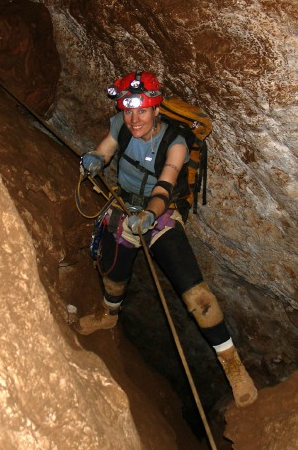 At the University of Akron, geology and biology professor Hazel Barton shows her students the ropes. Literally. A veteran caver, Barton combined her passion for exploring some of the most remote locations in the world with her scientific interest in microbiology and became a widely acclaimed expert on the communities of extremophiles living in caves.
At the University of Akron, geology and biology professor Hazel Barton shows her students the ropes. Literally. A veteran caver, Barton combined her passion for exploring some of the most remote locations in the world with her scientific interest in microbiology and became a widely acclaimed expert on the communities of extremophiles living in caves.
Here in the hallways of Sage Science headquarters, Barton is famous for another reason: she is the 1,000th customer of our Pippin automated DNA size selection platform. As we celebrate this milestone, we wanted to share a quick profile of Barton’s science here on our blog.
Barton went on her first cave expedition on a class trip at age 14, and has been caving ever since. She never expected this interest to mix with her career, until her postdoc advisor and 16S sequencing pioneer Norman Pace pointed out that she could get to places on Earth that most people couldn’t, giving her a remarkable opportunity to study microbiology in unexplored realms. “Rather than my hobby being something that was a distraction from my science, all the years of experience I had in caves allowed me to go in and recognize things that were unusual and that could be biological,” she says. Today, her research sites include caves in Kentucky, New Mexico, Venezuela, Brazil, Belgium, and China.
When Barton first began her explorations with microbiology in mind, conventional wisdom suggested that the physical isolation and lack of sunlight characteristic of caves would mean they couldn’t support much life. Barton’s early research demonstrated that there was actually “a profound level of diversity,” she says. “I spent the rest of my career trying to figure out why caves are so diverse and what are the community interactions that support that diversity.” She has unearthed insights into relationships that allow these extremophiles to survive, from the microbes that work together to break down scarce nutrients to share an energy source to the “cheaters” that eat bacteria and even out population levels.
For Barton and the students who accompany her into the depths of these caves — a favorite sampling site is some 1,500 feet underground — extracting DNA is no simple task. “These microbes are ingrained in the rock,” she says. “It’s very hard to study them.” A gram of soil, for instance, might contain four to five orders of magnitude more bacteria than a gram of cave sediment. To make things even more challenging, less than 0.1% of those microbes can be cultured back in the lab.
That’s why Barton, whose team specializes in generating libraries from low-biomass samples, turned to the Pippin Prep. Her lab had been finding it difficult to get enough product for 454 sequencing, but scientists at a collaborating center in Kentucky “would send us these beautiful images of these gels” that they had generated from the same sample. “They could effectively get 4 nanograms of product and we would just lose it all when we would gel purify,” says Barton. When she asked why, she learned that the center’s success was due to Pippin.
She brought Pippin Prep into her own lab for testing and decided it was a no-brainer to purchase the instrument. “For the first time in a long time, we were able to clone products that we hadn’t been able to clone before because there just hadn’t been enough DNA,” Barton says. “The Pippin is so valuable to us because it’s all about very low biomass and getting a high percentage recovery.”
Many thanks to Barton and all the amazing Sage Science customers who helped us get to this point. Here’s to the next thousand!





